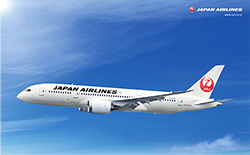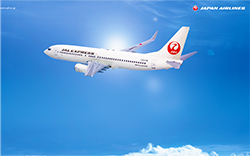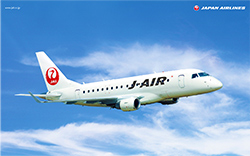- HOME
- CSR Activities
- The Environment
- Environmental Action Program
- Initiatives relating to flights in general
Investments to reduce CO2 emissions
The JAL Group continues to investment in CO2 emissions reduction. Currently, the most effective measure is renewal of aircraft to more fuel-efficient aircraft. In FY2014, we introduced five fuel-efficient 787-8's, and retired five 777-200, 767-300, and 737-400 aircraft. We plan aircraft investments of 161 billion yen in FY2015 and 187 billion yen in FY2016. We will introduce new fuel-efficient aircraft such as the 787-9, A350 and MRJ, and continue investments for aircraft renewal.
We investment in CO2 emissions reduction in ground facilities, too, To be specific, we continue to introduce LED lighting in maintenance facilities (hangars, docks), conserve electricity in offices, and change lighting to power-saving lighting.
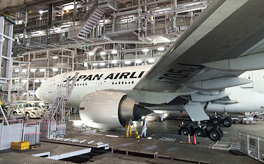
introduce LED lighting in maintenance facilities
Light-weight loads
Just like cars and other vehicles, the lighter the aircraft, the less fuel will be used and the less CO2 emitted. Since 2005, we have actively implemented measures to reduce the weight of loads (tableware, etc.) used onboard. In 2007, we introduced a light-weight container made of glass fiber for loading the passengers' baggage, which is about 70kg. lighter than the previous container, weighing about 100kg.
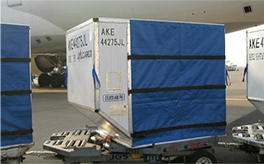
light-weight container
Improvement of on-time operations
At departure, the pilot requests the air traffic controller by radio for clearance to leave the spot and depart, on confirming that passengers have boarded, cargo have been loaded, etc., and preparations for department are completed.
The aircraft is permitted to taxi to the runway only after the air traffic controller clears the aircraft for departure. Clearance is basically issued on a first come first served basis.
Also, during flight, if the pilot wants to change the flight course to the destination or altitude due to weather conditions or turbulence that day, etc., the pilot makes a request to the air traffic controller and is permitted to change it only when approved by air traffic controllers.
This is also basically processed on a first come first served basis. Aircraft are operated according to the flight schedule, but on-time departure without any delay ensures not only on-time arrival at the destination, but also comfort such as choosing an altitude with less turbulence, and is beneficial for the environment as well, such as saving fuel and reducing CO2 emissions as a result of choosing an altitude and course with favorable tailwinds.
Please visit the site below for more information about on-time operations.
JAL Group Airlines Awarded Number One for On-time Arrivals in 2012User Preferred Route
UPR (User Preferred Route) is employed on Hawaiian, Australian, and North American west coast (Los Angeles, San Francisco, Vancouver) routes. Differing from the method of flying a route chosen from several pre-decided routes, the airline freely sets and flies a flight route based on weather conditions under specific limitations. This was made possible through the improved precision of aviation systems (system for aircraft to find its location) in recent years. Aircraft can shorten flight time by flying tailwinds, which leads to fuel saving and CO2 emissions reduction. Therefore, by actively using this operational method, we strive to choose routes and altitudes with, for example, strong tailwinds or little turbulence. It is calculated that CO2 emissions reductions of JAL Group on the whole through this advanced operational method are about 3,000 tons per year.
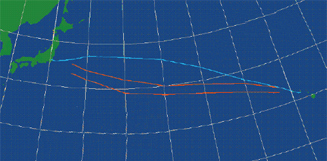
Example of UPR Blue line:
Example of UPR from Narita to Honolulu
Red line: Conventional route
More information on UPR is provided on the sites below.
JAL's San Francisco Service Receives Qualification for its Implementation of Operational Procedures to Reduce the Environmental FootprintParticipation in industry-government-academia collaboration initiatives for future air traffic control
The Ministry of Land, Infrastructure, Transport and Tourism's Aviation Bureau (JCAB) has launched Long-term vision for future air traffic systems (CARATS*) to make future air traffic systems safe, efficient and to address common global challenges such as climate change (global warming). CARATS is an approach in which industry, government, and academia cooperates and JAL is a member of it. Specifically, JAL collaborates in various ways, such as providing the actual flight data to researchers, collaborating with verification tests using flight simulators, and providing the opportunity to exchange opinions with the JCAB personnel and researchers.
(*)Collaborative Actions for Renovation of Air Traffic System

Biojet fuel
Development of biojet fuel is conducted in various countries aimed at significant reductions of CO2 emissions. JAL operated Asia's first test flight using non-plant biojet fuel using a Boeing 747-300 in January 2009. Afterwards, it participated in the establishment of the Net Generation Aircraft Fuel Initiative (INAF) to explore the possibility of exchanging information with organizations in Japan and overseas and develop biofuels in Japan. An "All Japan" system (46 industrial, academic and government organizations) held intensive discussions from May 2015 to March 2015. JAL actively participated as Secretary of the Working Group, which discussed ways of developing biojet fuel from city trash. As a result, this possibility was recognized through several production processes (see graph below) using municipal trash, which is significantly superior in terms of purchasing costs for materials, etc. JAL will actively participate in studies to produce and commercialize Japan-made biofuel by 2020, reuse resources disposed as trash for fuel, and take a big step forward in realizing a resource cycling society, which countries have been searching for.

